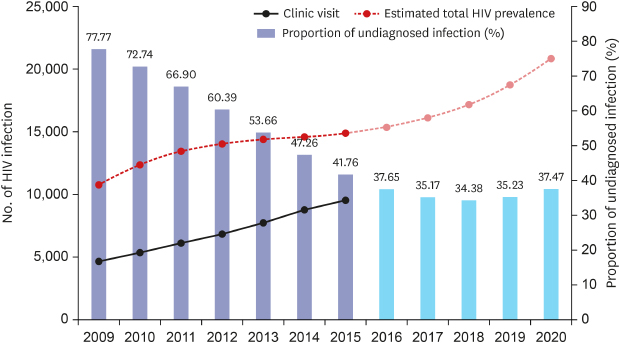1. Song R, Hall HI, Green TA, Szwarcwald CL, Pantazis N. Using CD4 data to estimate HIV incidence, prevalence, and percent of undiagnosed infections in the United States. J Acquir Immune Defic Syndr. 2017; 74(1):3–9.


2. Working Group on Estimation of HIV Prevalence in Europe. HIV in hiding: methods and data requirements for the estimation of the number of people living with undiagnosed HIV. AIDS. 2011; 25(8):1017–1023.

5. Nacher M, Adriouch L, Huber F, Vantilcke V, Djossou F, Elenga N, et al. Modeling of the HIV epidemic and continuum of care in French Guiana. PLoS One. 2018; 13(5):e0197990.

6. van Sighem A, Pharris A, Quinten C, Noori T, Amato-Gauci AJ. The Ecdc HIv/Aids Surveillance And Dublin Declaration Monitoring Networks. Reduction in undiagnosed HIV infection in the European Union/European Economic Area, 2012 to 2016. Euro Surveill. 2017; 22(48):17-00771.

9. Kaplan JE, Benson C, Holmes KK, Brooks JT, Pau A, Masur H, et al. Guidelines for prevention and treatment of opportunistic infections in HIV-infected adults and adolescents: recommendations from CDC, the National Institutes of Health, and the HIV Medicine Association of the Infectious Diseases Society of America. MMWR Recomm Rep. 2009; 58:1–207.


10. HIV prevalence estimates and AIDS case projections for the United States: report based upon a workshop. MMWR Recomm Rep. 1990; 39:1–31.
14. Gisslén M, Svedhem V, Lindborg L, Flamholc L, Norrgren H, Wendahl S, et al. Sweden, the first country to achieve the Joint United Nations Programme on HIV/AIDS (UNAIDS)/World Health Organization (WHO) 90-90-90 continuum of HIV care targets. HIV Med. 2017; 18(4):305–307.


16. Leierer G, van Sighem A, Rieger A, Schmied B, Sarcletti M, Öllinger A, et al. The continuum of care in Austria from 2010 to 2016: data and challenges. In : Proceedings of HIV Glasgow 2018, Poster Presentation; 2019 Oct 28-31; Glasgow, UK. p. P012.
18. Phanuphak P. Thailand's achievements in HIV treatment, prevention, and cure research. Proceedings of Conference on Retroviruses and Opportunistic Infections (CROI), Opening Session; 2019 Mar 4-7; Seattle, WA. Updated 2019. Accessed November 4, 2019.
http://www.croiwebcasts.org/p/2019croi/2011.
19. Nishiura H. Estimating the incidence and diagnosed proportion of HIV infections in Japan: a statistical modeling study. PeerJ. 2019; 7:e6275.

21. Korea Centers for Disease Control. 2017 HIV/AIDS Annual Report. Cheongju: Korea Centers for Disease Control;2018.
23. Huang MB, Ye L, Liang BY, Ning CY, Roth WW, Jiang JJ, et al. Characterizing the HIV/AIDS epidemic in the United States and China. Int J Environ Res Public Health. 2015; 13(1):h13010030.

24. US Preventive Services Task Force. Owens DK, Davidson KW, Krist AH, Barry MJ, Cabana M, et al. Screening for HIV infection: US Preventive Services Task Force recommendation statement. JAMA. 2019; 321(23):2326–2336.

25. Lee SY. The change of route of HIV transmission for the past 11 years in Korea and the projection of the HIV/AIDS cases to the year 2000. Korean J Prev Med. 1996; 29(2):331–346.
26. Lee JY, Hwang JS, Goh UY, Kee MK, Kim JY. Prediction of HIV and AIDS incidence using a back-calculation model in Korea. Korean J Prev Med. 2002; 35(1):65–71.
28. Choe KW. Epidemiology of HIV/AIDS-current status, trend and prospect. J Korean Med Assoc. 2007; 50(4):296–302.
31. Choi BY, Choi JY, Han SH, Kim SI, Kee MK, Kim MJ, et al. Korea HIV/AIDS cohort study: study design and baseline characteristics. Epidemiol Health. 2018; 40:e2018023.

32. Touloumi G, Pantazis N, Pillay D, Paraskevis D, Chaix ML, Bucher HC, et al. Impact of HIV-1 subtype on CD4 count at HIV seroconversion, rate of decline, and viral load set point in European seroconverter cohorts. Clin Infect Dis. 2013; 56(6):888–897.


33. Kim GJ, Nam JG, Shin BG, Kee MK, Kim EJ, Lee JS, et al. National survey of prevalent HIV strains: limited genetic variation of Korean HIV-1 clade B within the population of Korean men who have sex with men. J Acquir Immune Defic Syndr. 2008; 48(2):127–132.










 PDF
PDF Citation
Citation Print
Print




 XML Download
XML Download